Total Football Analysis
·21 July 2020
FA Cup 2019/20: Manchester United vs Chelsea – tactical analysis
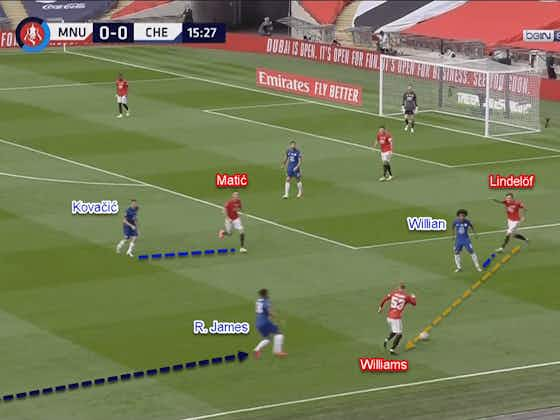
Total Football Analysis
·21 July 2020

Manchester United’s dream to continue their unbeaten run has come to an end. It was Chelsea who finally end the streak in last weekend’s FA Cup semifinal. The Blues will face Arsenal in the final, who defeated Manchester City with a similar two-goal margin just a day before.
Ole Gunnar Solskjær and Frank Lampard approached this game rather cautiously. They moved from their regular formations and decided to start the match with three centre-backs. Despite the similarity on paper, both managers deployed different tactics on the pitch. Without further ado, this tactical analysis will inform you how the match unfolded.

Solskjær opted for 3–4–1–2 in this game, moving from the regular 4–2–3–1 he always chose since Project Restart began. The trio of Eric Bailly, Harry Maguire, and Victor Lindelöf was chosen to play at the heart of United’s defence. Meanwhile, at the top, the duo of Daniel James and Marcus Rashford was supported by Bruno Fernandes behind them. Names like Paul Pogba, Anthony Martial, Timothy Fosu-Mensah, Odion Ighalo, and Mason Greenwood had to start the game from the bench.
Lampard, on the other side, opted for 3–4–3. The shape can swiftly move to a back-five system with wing-backs Reece James and Marcos Alonso dropping in parallel with the centre-backs. Upfront, Lampard chose Olivier Giroud to spearhead Chelsea’s attacks, flanked by Willian and Mason Mount. Their dugout was filled with players like Tammy Abraham, Pedro Rodríguez, Ruben Loftus-Cheek, and Callum Hudson-Odoi.
The Blues used well-planned defensive tactics in this game. First of all, they started with a rather high 5–2–3 pressing shape. In that formation, Chelsea tried to block all the central lanes and prevent United’s midfielders from being accessed. The objective was to make the Red Devils build their attacks from the flank.

When the ball is on its way to Aaron Wan-Bissaka or Brandon Williams’ feet, Chelsea would execute their press. In the process, Chelsea’s ball-side wing-back would step up and press United’s on-ball wing player. Then, all the nearby passing options will be closed. Those include United’s nearest midfielder as well as the centre-back. This might force United to deploy longer balls.

However, they persisted on building through their midfielders. It means that even when the ball has moved wide, the wing-back was instructed to send it back inside either to Fred or Nemanja Matić. Lampard seemed to realise this would happen, thus reacting brilliantly.
Let’s go back to Chelsea’s first pressing movement, where their ball-side wing-back came up to press United’s on-ball wing-back. When that was happening, another chain of movements was also taking place in another part of the pitch. In this sequence, Chelsea’s far-side winger would drop down and close United’s far-side midfielder. By doing that, this allowed the other Chelsea midfielder to stay back and protect the central lanes as well as preventing Fernandes to be accessed diagonally.
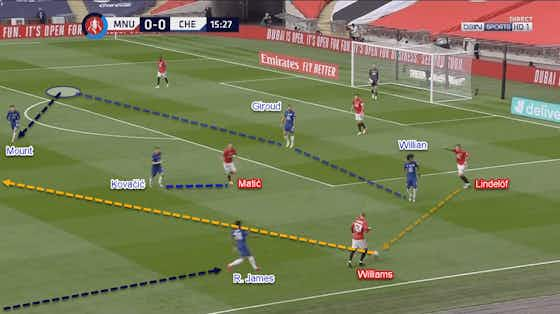

This part of the analysis will take a look at United’s main offensive tactics. To bypass Chelsea’s press, United would try to play a grounded vertical pass to one of the attackers. Their target was mainly Fernandes, but sometimes either Dan James or Rashford could also offer themselves to be the receiver. The main distributor were the centre-backs, and even Matić on some occasions.
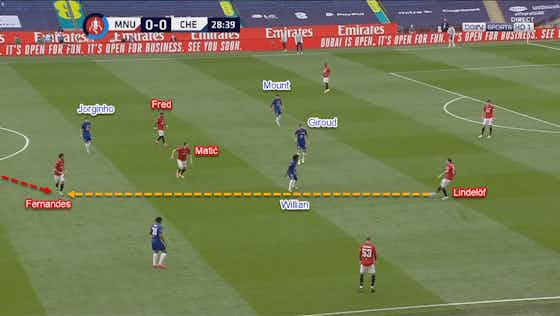
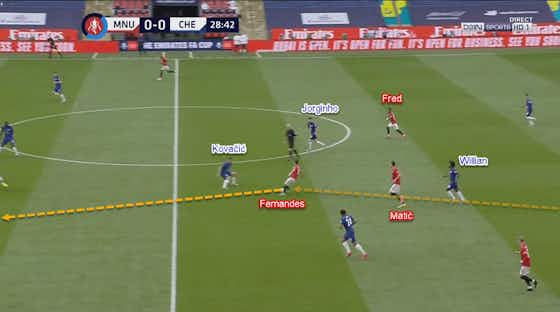
When the ball has arrived at Fernandes’ feet, he would try to find his attacking comrades in behind as quickly as possible. In the process, he could vary from using a grounded pass in between the defenders or using a lofted through-ball. The objective behind that was to utilise Dan James and Rashford’s exquisite pace.
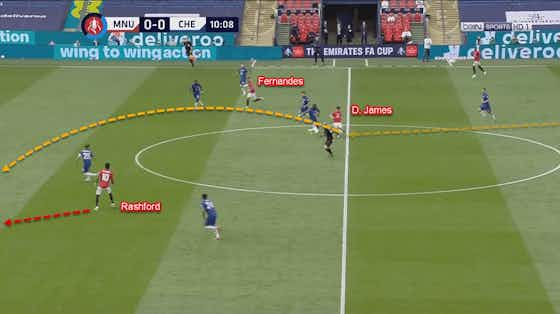
However, this approach didn’t work perfectly. If we look at the stats, Matić only managed to finish the game with four (50%) progressive passes completed. Fernandes’ achievement wasn’t good either. He only made three (21.43%) accurate through-balls throughout the match.
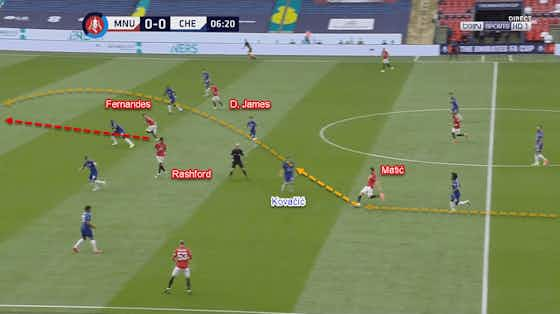
Quite similarly, United also used a rather high 5–2–3 as their go-to pressing structure. The three-man system upfront was picked to mirror Chelsea’s three-at-the-back, thus closing all short options at the same time. When one of the centre-backs have the ball, United’s frontmen would not press aggressively. Instead, they would try to force Chelsea to build through the flanks.
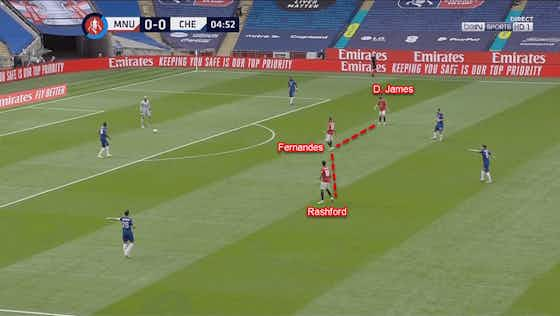
In an almost identical fashion, United’s ball-side wing-back would step up to press Chelsea’s on-ball player in the flank. The Red Devils also tried to close all nearby passing options for the wing-back on possession. Those include the centre-back as well as the nearby midfielder.
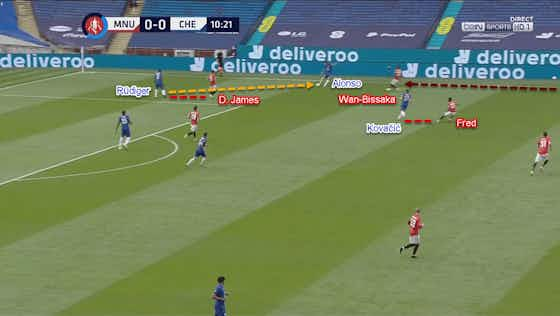
However, Chelsea didn’t try to force their way in centrally. Instead, they would try to bypass the aggressive press by sending long balls to Giroud, even directly from the wing-back. Good for Chelsea, the Frenchman possesses supreme strength to win physical duels against United centre-backs.
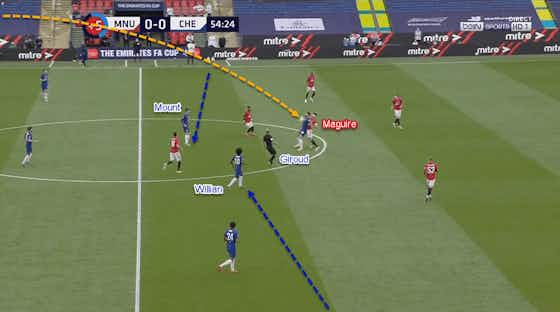
Giroud wasn’t alone to win the long balls, though. He was supported by both Willian and Mount, who will come close to offer themselves as lay-off options. Not only that, but one of the midfielders could also step up to serve as a potential rebounder. For a fact, Chelsea’s first goal was started by Giroud laying an aerial ball to Jorginho.
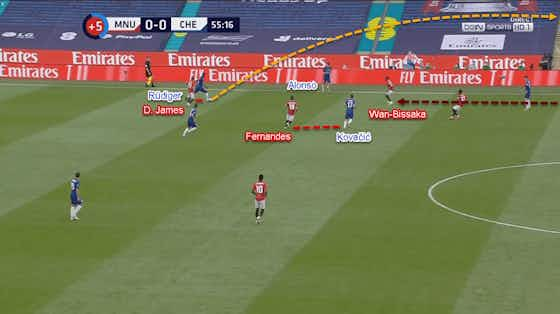
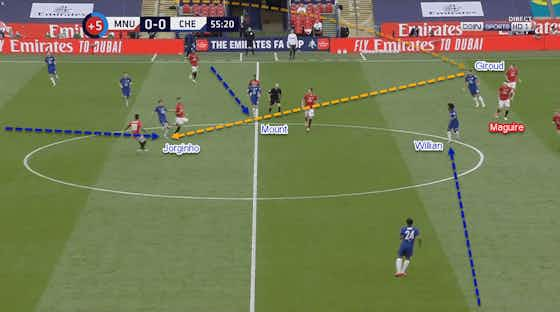
Due to United’s aggression, Giroud could also be accessed by Chelsea’s centre-backs or even the goalkeeper Willy Caballero. If we look at the statistics, Caballero finished the game with 13 (68.42%) passes to United’s pitch. Five (38.46%) of them went accurately to the towering targetman.
Chelsea also attempted to build their plays from the back. However, they couldn’t do that without any tactical tweak as United were able to mirror Chelsea’s set-up in their early third. Quite interestingly, Lampard used a carbon-copy approach from their final opponent, Arsenal. That being temporarily moving to a back-four when having the ball.

In this process, Azpilicueta would drift wide and play as the makeshift right-back. This would help the Blues have a numerical advantage against United’s attacking trio. In front of the Spaniard, Reece James would step up and play in parallel with the attackers. This particular movement by the wing-back would give Chelsea another advantage in the latter phase of their attacks.
Azpilicueta’s main role was to be the free man due to the overload at the back. However, it wasn’t only that. He could also move forward rather freely into the final third, either by driving with the ball or just advancing without it. That’s because United’s midfield duo was focusing to close central lanes while leaving the left flank completely free. Besides that, Williams could not press marauding Azpilicueta because Reece James was pinning him back.

In the final third, Azpilicueta and Reece James gave Chelsea another overload; now against Williams. They could also easily rotate as both of them are comfortable playing wide or inside the half-space. Sometimes, one of United midfielders would drift wide to prevent this from happening. But, Chelsea also had Willian as the right-winger. The Brazilian could help his teammates by joining the overload.
The objective behind this flank overload (and rotation) was to send a player free to send crosses into the box. This is why Azpilicueta could finish the game with three (60%) successful crosses, including the first-half assist to Giroud.

Speaking about crosses, Chelsea started the game by using aerial crosses more often. The main target was, of course, Giroud, but sometimes the far-side wing-back and/or the winger could also pop up inside the box to serve as potential receivers. This aerial approach didn’t work perfectly, though. That’s because United had three towering centre-backs inside the box. The defensive trio combined to win 10 (71.43%) aerial duels throughout the game.
Lampard then instructed his team to use ground crosses more often, especially when United returned to their regular 4–2–3–1. The statistics gave proof to the effectiveness of this tactical change. For a fact, Chelsea only managed to send 33.33% of their crosses accurate in the first half. In the second half, their accuracy rate was 50%; not including Maguire’s own goal from Alonso’s cross.
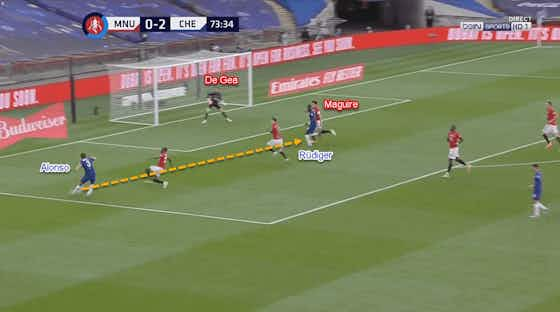
United permanently shifted into 4–2–3–1 in the second half. In that shape, they would utilise the full-backs to provide width, while all the attackers play narrowly. The deeper players — mainly the midfielders — would try to find them in between the lines. The objective behind that was to allow United’s attackers to create chaos in that dangerous area. We could also see a glimpse of this approach in the first 45 minutes, but not quite often.
However, this particular approach didn’t work as good as expected. The first reason was the attacker(s) sometimes closed their body orientation when receiving, which made them easier to contain. At other times they could also control the ball loosely, and give the ball away to the men in blue.

Another factor was from their opponents. To combat United’s combination play, Lampard tasked the ball-side centre-back to aggressively press United’s receiver in between the lines. Sometimes this didn’t work well because United won a couple of free-kicks just outside the box. But, that was more anomaly than the norm. The stats proved this by United’s very low open-play expected goals (xG) tally, which only stood at 0.22.
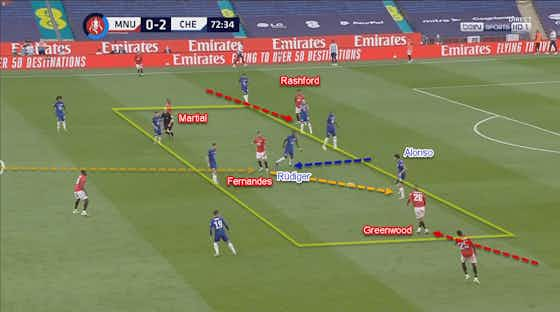
Lampard initially allowed United to have more possession in the second half. However, he changed his mind late in the game. He seemed to realise that sitting back and soaking constant pressure was not the best option for his team.
His first tactical change was by subbing out Willian and Giroud for Hudson-Odoi and Abraham. Minutes later, Loftus-Cheek and Pedro were introduced for Kovačić and Mount. These changes gave Chelsea four fresh pair of legs, which three of them belong to the attackers.
The second tactical change was instructing his team — especially the attacking line — to be more aggressive when pressing United’s deeper players. By doing so, they would prevent the Red Devils from comfortably enjoying possession. Even further, this would help Chelsea to create more attacks late in the game.

For a fact, Chelsea only had 36% of possession in the first 30 minutes in the second half. This number then increased quite massively in the closing quarter-hour of the game. The Blues were able to get 48% of the ball from Abraham and Hudson-Odoi came in until the final whistle.
Similar shapes, but different tactics. Lampard’s use of Giroud to bypass United’s press was nothing short of brilliant. His upper-body strength, as well as good link-up plays, was the main difference between the two teams. Another clever tactic the Englishman deployed was the adventurous role of Azpilicueta. From time to time the captain showed his high level of quality, especially in attacks.
Solskjær, however, didn’t get the result with his cautious approach. He wasn’t lucky either with Bailly coming out injured just minutes before the first-half finished. Yet, that wasn’t even the main talking point of the game. It was (another) De Gea disastrous display between the sticks that practically gave away the match to Chelsea.
The Norwegian manager now has a huge dilemma. With two crucial Premier League games and a UEFA Champions League ticket at stake, will he boldly play Sergio Romero next week or will he keep trusting the Butterfinger Spaniard in United’s goal?






























































